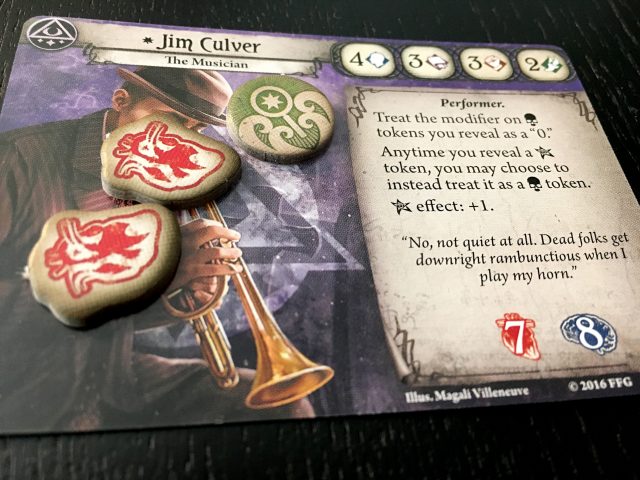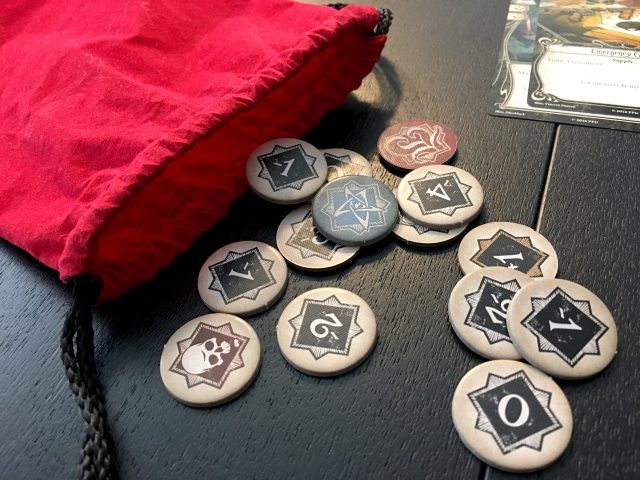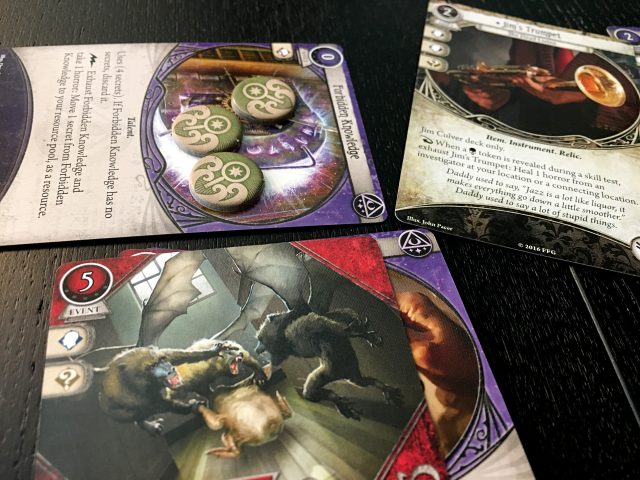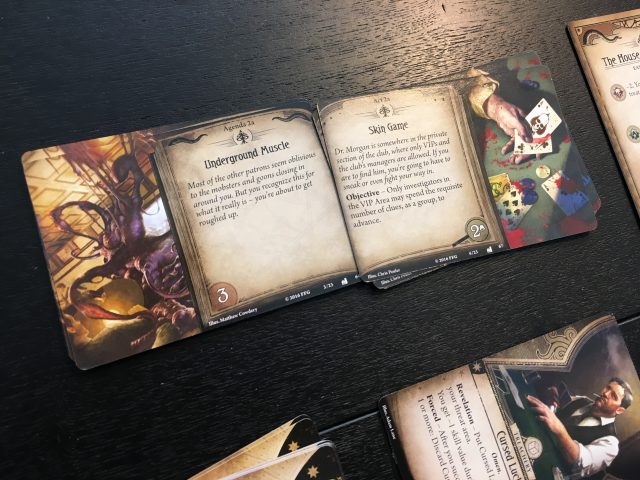In the beginning, there was H.P. Lovecraft. Writing in the 1920’s and 30’s, he is best known for a series of short stories and novels he wrote set in contemporary Massachusetts where ancient gods of unspeakable horror keep pushing into the world, with nightmarish consequence. Those who investigate are inevitably driven insane.
Never successful in his lifetime, Lovecraft’s flame was kept alive by a small circle of friends and admirers. They added to his canon with what we would call “fan faction” set in his universe. Eventually, writers such as Fritz Leiber (who literally invented the term “sword and sorcery”) and Robert Bloch (author of “Pyscho”, #showerscene) became mainstream successes and through them and others interest in Lovecraft’s writing blossomed.
 With the rise of roleplaying games in the 1970’s Lovecraft’s creations became game-ified. In the Deities and Demigods sourcebook for Advanced D&D there was a section set aside for Lovecraft’s creations. I can still remember reading that section of the book with fascination as a twelve-year-old; C’thulu and Yog-Shoggoth were so different from Zeus, Ra, and Odin. What kind of warped gods were these??
With the rise of roleplaying games in the 1970’s Lovecraft’s creations became game-ified. In the Deities and Demigods sourcebook for Advanced D&D there was a section set aside for Lovecraft’s creations. I can still remember reading that section of the book with fascination as a twelve-year-old; C’thulu and Yog-Shoggoth were so different from Zeus, Ra, and Odin. What kind of warped gods were these??
Then, in 1987, Chaosium Inc. (publishers of beloved titles such as White Bear & Red Moon) released an Arkham Horror board game. The design team included youngsters Richard Lanius (“Defenders of the Realm”, “Run, Fight, or Die!”) and Sandy Petersen (“Cthulu Wars”, “Orcs Must Die! The Boardgame”). It attracted a devoted fanbase, but remained a cult favorite until 2005 when, at the invitation of Fantasy Flight Games Lanius teamed up with Kevin Wilson to release a new version which for many has become the definitive Lovecraft experience.
I have never played this version of Arkham Horror. The sessions I heard about took hours, the tablespace needed to hold the many, many piles of cards was prohibitively large, and…I dunno, it just felt too overwhelming in scale for me. A dice-driven Elder Sign app came out in 2011 and I played that a lot, and still play it occasionally. (The physical version was designed by Lanius and Wilson as well but I preferred to have the app take care of all the fiddly bits.) Then Eldritch Horror came out in 2013 and was billed as a streamlined Arkham experience, but maybe because I played with five people the downtime seemed huge.
So all in all I was still searching for a C’thulu-themed experience that was (a) playable in a decent amount of time; (b) didn’t have too many things to keep track of; (c) didn’t require a huge table; and most importantly, (d) delivered a solid Lovecraftian experience.
And that brings us to last year’s Arkham Horror: The Card Game. Released by FFG and designed by the same guy (Nate French) that brought us 2011’s hugely successful Lord of the Rings: The Card Game, could this be the game that I was looking for?
TL; DR: Yes, but cost.
* * *
 AH:TCG shares several basic mechanics with its LoTR predecessor. Each player represents a single Investigator with a uniquely-constructed deck of cards. Investigator cards include Assets (stuff, some permanent, some of which have a limited number of uses), Events, Allies, and Weaknesses (Unavoidable Bad Events). Between scenarios, Investigators can use accumulated Experience to upgrade their decks. Players can start with pre-designed decks, or (as in LoTR:TCG) build their own to meet the challenges of particular scenarios.
AH:TCG shares several basic mechanics with its LoTR predecessor. Each player represents a single Investigator with a uniquely-constructed deck of cards. Investigator cards include Assets (stuff, some permanent, some of which have a limited number of uses), Events, Allies, and Weaknesses (Unavoidable Bad Events). Between scenarios, Investigators can use accumulated Experience to upgrade their decks. Players can start with pre-designed decks, or (as in LoTR:TCG) build their own to meet the challenges of particular scenarios.
In LoTR:TCG, the party progressed through a Quest together by travelling (figuratively) from area to area, moving on only when they had accumulated enough “Progress”. Each stage of the Quest had baddies to fight, who would swoop in and engage or lay out and snipe from afar. To me it all felt a bit abstract, and was one of the reasons I abandoned the game.
AH:TCG, on the other hand, is more thematic and engaging (in my opinion) through the use of Location, Agenda, and Act cards. Location cards are set out at the beginning of a scenario, acting as a network of interconnected places where Things can happen. Sometimes Locations are rooms within a building; other times they are buildings or neighbourhoods, allowing for different scales of action. In some cases there are multiple cards for the same Location, only one of which is used in a given session, which increases uncertainty and replayability.
Investigators can choose to stick together or split up. This is often a key decision to make, as Investigators in the same Location can help each other out, but since time is always of the essence splitting up means you cover more ground more quickly. Locations can have special effects, and usually contain a certain number of Clues which must be ferreted out in order to move the story along.
 Speaking of which, the Agenda and Act cards act as both hourglass and reward system. Their graphic design encourages you to place them side-by-side so they look like a book, and as their pages “turn” so does your adventure. The Agenda cards accumulate Doom, which is Bad but Unavoidable, and when the amount of Doom hits the marked threshold you are forced to advance to the next Agenda card, which inevitably ratchets up the Badness.
Speaking of which, the Agenda and Act cards act as both hourglass and reward system. Their graphic design encourages you to place them side-by-side so they look like a book, and as their pages “turn” so does your adventure. The Agenda cards accumulate Doom, which is Bad but Unavoidable, and when the amount of Doom hits the marked threshold you are forced to advance to the next Agenda card, which inevitably ratchets up the Badness.
On the other hand, the Act cards operate like the Quest cards in LotR:TCG; when you meet the conditions of the Act you get to move on. Often the condition is accumulating enough Clues (which scale according to the number of Investigators), and cashing them in, but there are other possible scenario-specific triggers, which adds to the theme and variety of strategies needed to beat the game. When you meet the objective on the last Act card, you generally “win” the game. “Win”, because in this game very few things are purely good.
Each scenarios is played in a series of rounds, starting with Doom accumulating (and possible Agenda advance). Next each Investigator draws and resolves a card from an Encounter deck (whose composition differs from scenario to scenario). This generally results in punishment of some kind, whether from newly-spawned enemies or nasty effects. The Investigators then get to take actions: play cards, move around, investigate, fight, interact, flee. Finally, cards refresh, some enemies come a-hunting, each Investigator gets new cards and supplies, and on you go until either you finish the last Act or run out of Health, Sanity, or time. That last thing happens quite a bit.
Much of the game revolves around Skills Checks. Whenever you try to do almost anything, you start with one of your stats (Willpower; Intellect; Combat; Agility), modify it by a bunch of stuff, and finally draw a Chaos Tile out of the Chaos Bag which modifies it some more (usually in a bad way). If the result is not negative you have succeeded at your task. Otherwise, at best, nothing happens, but sometimes (there are some Tiles with symbols whose meanings depend on the scenario) even more Bad Stuff happens.
The cool thing is, the mix of Tiles in the Chaos Bag can be set to make the game easier or harder, which makes calibrating difficulty incredibly easy. Score one more for the game here.
 Having played through the campaign that came in the base set, and having tippy-toed into the next campaign and some standalone scenarios, I can say that AH:TCG satisfies all the things on my wishlist. Each scenario takes a couple of hours to play, setup and takedown is a breeze—although if you’re starting from scratch, assembling the decks can take a while. You’re basically only keeping track of your own Investigator’s Health and Sanity, and some scenarios require a tiny bit of note-taking which, actually, feels quite thematic (because Investigators). Table footprint is fine—although this is mainly because the game is designed for one or two players only. This I know is a downer for some, but for me, being able to play solitaire is a plus. Finally, the game does a great job thematically, from the graphic design to the flavour text to the design of the scenarios themselves—which I have demonstrated can be quite different from one to the next (yeah, looking at you Pathfinder:TCG).
Having played through the campaign that came in the base set, and having tippy-toed into the next campaign and some standalone scenarios, I can say that AH:TCG satisfies all the things on my wishlist. Each scenario takes a couple of hours to play, setup and takedown is a breeze—although if you’re starting from scratch, assembling the decks can take a while. You’re basically only keeping track of your own Investigator’s Health and Sanity, and some scenarios require a tiny bit of note-taking which, actually, feels quite thematic (because Investigators). Table footprint is fine—although this is mainly because the game is designed for one or two players only. This I know is a downer for some, but for me, being able to play solitaire is a plus. Finally, the game does a great job thematically, from the graphic design to the flavour text to the design of the scenarios themselves—which I have demonstrated can be quite different from one to the next (yeah, looking at you Pathfinder:TCG).
AH:TCG has already cracked BGG’s top 100, and is the highest-rated “customizable” game in the database, even higher than its predecessor, LotR:TCG (#9) and Magic: the Gathering (#22). I don’t know if it will stay on the throne for long, but it certainly deserves a lot of praise.
There’s just one tiny problem with it.
* * *
The base game costs $46 (Canadian), contains the first campaign of 3 scenarios, and enough cards to play any Investigator solo, but not enough cards that you can pick any two and play them together. The second campaign, The Dunwich Legacy, costs $34, and despite having five new Investigators to choose from you still cannot play all possible pairs with the cards provided. This forces some kinds of players to buy 2 of each base set and expansion just so they don’t have to waste time deconstructing and reconstructing decks. Seriously, how much more would it have cost FFG to provide enough cards to avoid this?
Not only that, but Dunwich Legacy doesn’t even contain a full campaign—only the first two (of eight!) scenarios. To finish the second campaign you’re going to have to fork out $18 each for the remaining scenarios! That’s $142 (before tax) for a single campaign.
WTF, FFG?
Yes, that represents many hours of entertainment and enjoyment, AND it’s replayable with different Investigators and difficulty levels. But still. It feels greedy. Plus why string out the scenario releases instead of releasing them all in one box? (Probably because they know their fanbase will buy everything regardless and because most people would rather shell out $18 every couple of months than $120+ in one pop.) But still. Annoying. And greedy. Plus the base set box isn’t even big enough (unlike the LotR:CCG box) to hold all the cards and expansions.
So, yes, I will grit my teeth and buy-to-play my way through Dunwich Legacy, but then, unless the game totally rocks my world, I’m stopping there. I give the game and its designers its due: it is probably the closest I will come to my perfect Lovecraftian experience. And I will thank my lucky stars that I don’t have to buy any booster packs (see: M:tG) or worry about power creep or an ever-evolving meta that I can’t keep up with (see: Netrunner).
Maybe down the road FFG will release an all-in-one big-box version of AH:TCG that will be more affordable. And if you don’t have the almost $200 to would need to commit, I hope you find a friend who does, or a group of friends who can pool resources together to share it. It’s a great game.
[…] self-contained (so that I didn’t have to keep up with endless expansions. A couple of months ago I wrote about a game which came pretty close to the mark, and I have a couple of other favorites (Epic, for […]
I have noticed you don’t monetize your blog, don’t waste your traffic, you can earn additional bucks every
month because you’ve got high quality content.
If you want to know how to make extra money,
search for: Ercannou’s essential adsense alternative